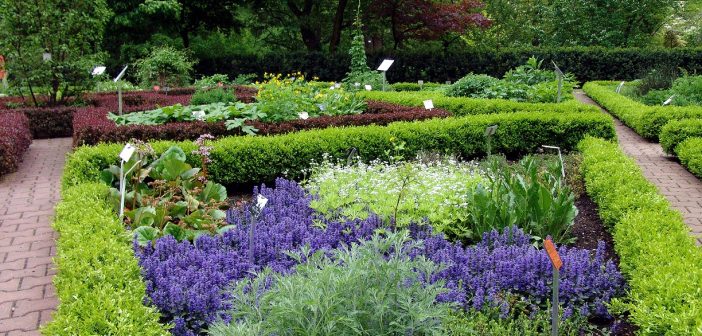When you think of herbs, you probably think first of delicious flavors and aromas that add a boost to your favorite dishes. Basil and oregano are staples for Italian dishes. Sage sausages can serve as a centerpiece for Sunday breakfast. Rosemary and thyme make a leg of lamb a special treat. However, herbs can also be a beautiful addition to your home’s landscape. Here are many tips and ideas for using these tasty herbs as beautiful landscape.

Traditional Herb Garden
Many of you may have grown popular herb gardens in your yard, which can be beautiful in and of themselves. You have a wide selection in the market today of unique pots and planters, ladders, trellises and other outdoor decor designed for creating an herb garden to suit your patio, deck or backyard.
Movable Container Garden
Herbs can be easily grown in containers, which can be placed together or as accents around your balcony or deck. You can easily move your herb containers to change the look of your landscape or for more practical reasons like avoiding inclement weather, desiring more sun or easier access during cooking. You gain more control of a container herb garden because you can create an ideal soil mix for the pots as well as fertilize and trim your plants regularly.
Ground Covers
Herbs that grow well and quickly on a flat surface can make excellent ground covers that can replace sections of grass to not only add unique beauty to a landscape but reduce or eliminate mowing. If you have a shady, moist area on your property, mint works well as a ground cover. It will reproduce quickly, however, so be sure you don’t mind mint spreading to nearby areas. Creeping rosemary is an excellent ground cover for dry climates and remains green year round. Oregano, or wild marjoram, can also be used in drought-prone areas as an edible option for ground cover.
Path Borders
Since thyme can tolerate people stepping on the plants without immediate damage, this herb works well as a decorative border for paths around your property. The alpine strawberry also makes a sweet-smelling, attractive border against garden paths. Other low-growing, creeping herbs like oregano and mint can be used as well.
Rock Garden Partner
Several types of herbs grow well among rocks but not at all in typical well-drained, loose garden soil. The herbs that are native to the Mediterranean are used to sunny hot summers and dry, alkaline, rough terrain. If you have a rock garden in your landscape, consider inter-planting herbs such as sage, sumac, tarragon, or yarrow.
Fill in Concrete or Stone Paths and Patios
Many homeowners enjoy stone or concrete garden paths and patios. Usually, keeping the weeds out of cracks and crevices can be an ongoing chore. Instead of fighting weed growth in these cracks, consider planting some herbs that can beautify the areas. Many herbs release a fragrant scent when stepped on, adding a lovely aroma to your outdoor space. Some candidates for this application include blue haze, chamomile, thyme and American maritime.
Topiaries
Lovely topiaries can be created from herbs that naturally grow upright. They are small enough and grow quickly enough to be trained and manicured into beautiful indoor or outdoor decorations. Topiaries can be set along garden paths, in entryways, and on patios and decks. You may want to try your hand at creating topiaries with myrtle, lavender, drawf sage, or rosemary.
Living Walls
Another use for upright-growing herbs is to create a natural wall or border in your landscape. As with topiaries, the herbs that can be trained and trimmed can be taught to grow as a low wall or hedge in selected garden spots to add to the beauty and ambiance of your outdoor space.
Trellis and Arbors
These vertical growing or climbing herbs can also be trained to cover a trellis or an arbor to provide shade as well as beautiful decor in your garden or patio area.
Naturalize Landscapes
If you have wooded areas or a wildflower prairie on your property, you may find that certain herbs can add color and variety to these natural spaces. Several medicinal herbs such as black cohosh, blue cohosh, and yellow lady’s slipper grow well in wooded areas.
Flower and Vegetable Complements
By interplanting various herbs in your vegetable or flower garden, you may be able to effectively protect them from common pests. For example, cabbage moths hate anise hyssop and potato beetles dislike catmint. Take some time to research which herbs may protect your favorite flowers or vegetable crops. In addition, some herbs can add colorful flowers and visual appeal to conventional flower gardens. Anise hyssop produce stunning lavender blue flowers. Bee balm flowers are a magnificent red, pink or purple. Rue is a beautiful plant with blue-green foliage and eye-catching yellow-green flowers.
Hanging Baskets
Adorning your patio or garden structures with hanging baskets full of herbs is another beautiful and practical way to incorporate herbs into your landscape. Catnip, rosemary and marjoram lend themselves to growing well in hanging containers.
With a little creativity, you can use herbs as a unique, edible and beautiful addition to any landscape around your home.







